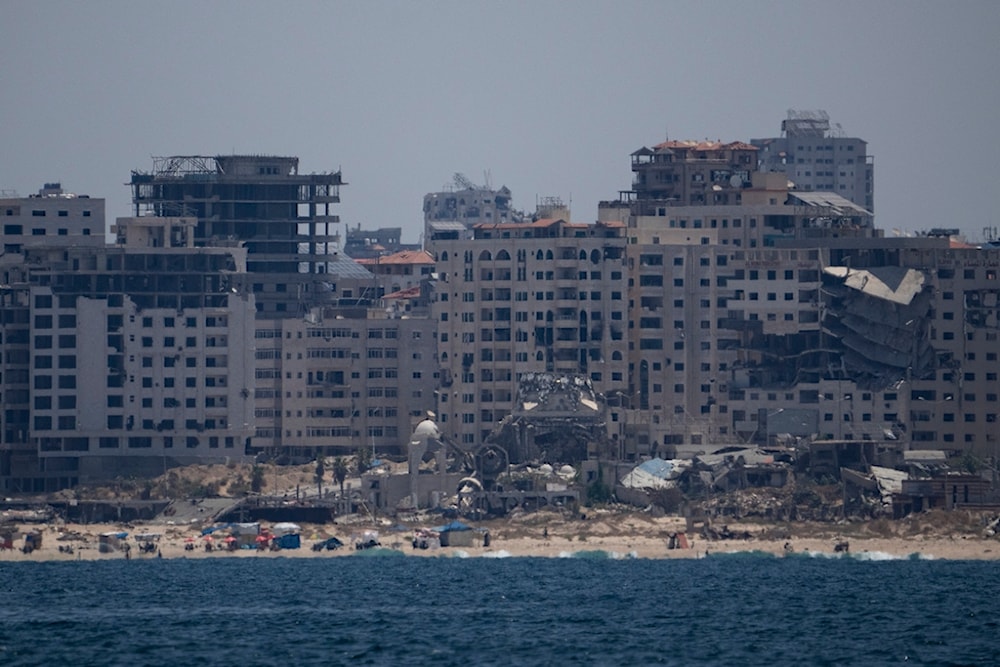US Gaza floating pier dismantled, again, due to high 'sea states'
According to the Pentagon, relocating the pier temporarily aims to prevent potential structural damage due to the forecasted adverse weather conditions.
-

Destroyed buildings stand on the coast of the Gaza Strip as seen from the Mediterranean Sea, Tuesday, June 25, 2024. (AP)
The US military floating pier off the coast of the Gaza Strip has been dismantled as a precautionary measure against anticipated rough sea conditions, the Pentagon announced on Friday.
"Due to high sea states expected this weekend, Central Command has removed the temporary pier from its anchored position in Gaza and will tow it back to Ashdod, Israel," Deputy Pentagon Press Secretary Sabrina Singh told reporters.
Singh noted that relocating the pier temporarily aims to prevent potential structural damage due to the forecasted adverse weather conditions.
The decision to remove the pier was made following careful assessment and consideration of the sea state forecasts.
While the Commander continues to monitor the sea states over the weekend, Singh said she could not provide a specific date for when the pier will be reinstalled.
Read more: US pier in Gaza under fire for ineffectiveness as civilians starve
US Gaza pier spent more time being fixed than used
The $230 million floating pier linked to the shore of Gaza, a crucial component of President Joe Biden's strategy to allegedly assist Palestinians during the war on Gaza, has spent more time out of service than operational, Newsweek reported. Since its inception on May 17, the pier has only been active for 12 out of 38 days.
Initially set up by US military personnel on May 17, the pier was meant to significantly ease the delivery of aid to Gaza's starving population. However, high waves dislodged the pier just over a week after its deployment, halting aid deliveries.
In reality, just a few dollops have landed in Gaza. During the limited period, the dock was operational before the storm, roughly 27 trucks departed per day, with plans for 150, knowing that the Gaza Strip needed at least 600 per day to avoid famine.
The Pentagon reported that the US restarted assistance delivery through the pier on Thursday after removing it for the second time on June 14 due to inclement weather. After breaking apart in severe waves, the pier was dismantled and transported to the Israeli port of Ashdod for reconstruction.
Pallets of food and medication arriving by sea have built up on the beach on many of its active days due to a lack of vehicles needed to transport the supplies to warehouses around the Gaza Strip. Some officials have questioned the project's feasibility in these circumstances.
Read more: Republican lawmaker demands the closure of pier in Gaza
On June 26, it was reported that "Israel" used aid trucks to retrieve captives, an operation that cost the lives of at least 210 Palestinians in the Nuseirat refugee camp, and that the US provided intelligence for "Israel" to carry out this operation.
According to NYT, a team of American experts stationed in Israeli-occupied lands supported the Israeli military in retrieving the four captives by giving information and other logistical support.
Since its plan was revealed, the real purpose of the pier has been widely debated as it can represent the basis for a future permanent US military base on the shores of Palestine under the pretext of delivering aid.
The pier could also serve as a choke point for aid in the post-war situation, as such deliveries could be linked to political pressure on the people of Gaza and the Resistance to submit to future US diktats.
Following the Nuseirat massacre, humanitarian organizations expressed deep concern that their workers may face serious risks carrying out their duties.
"The potential risk to aid workers was something WFP and the UN pushed back on from the beginning," said a senior aid representative. "They knew the concerns and expressed those concerns upfront. What the IDF did made everything more difficult."
Read more: 'Israel' used aid trucks to retrieve captives, now NGOs fear working

 4 Min Read
4 Min Read








